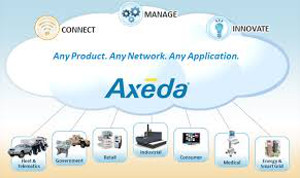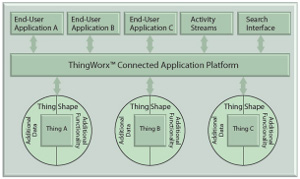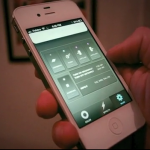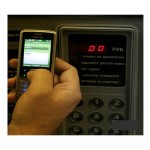The Axeda Machine Cloud platform is a secure and scalable cloud platform for connected products, machine-to-machine and Internet-of-Things networks which is backed up by professional, commercial support and a growing library of technical content and resources.
This versatile platform enables system integrators, solution architects, and developers to quickly and easily connect, manage and innovate powerful machine-to-machine systems, connected products and IoT applications, potentially faster and at a lower cost than with internally built solutions.
Covering a wide spectrum of areas, the Axeda platform addresses the complex requirements that are often invisible but vital to overall success, providing an end-to-end M2M solution, and not just the application user interface that your end-users see. The Axeda platform enables you to connect and communicate with any wired or wireless asset, innovating with M2M and IoT connectivity for connected product solutions.
As part of the Axeda platform, their “Machine Cloud” service includes M2M and IoT connectivity services, software agents and toolkits that enable you to establish connectivity between your devices or assets and the Axeda platform while allowing you to choose the communication methods and hardware that best suit the needs of your IoT solutions. Thus you can connect to any product using any device over any communications channel including cellular networks, WiFi, satellite, or any form of Internet connectivity, for any application.
Axeda’s M2M connectivity services include multiple types of solutions, covering different classes of devices or assets that you may need to connect to. Axeda firewall-friendly agents are software agents that run on Linux or Windows and install directly on your asset devices (if equipped with these operating systems) or on a gateway computer on your network that is connected to your assets, providing user-friendly cloud service connectivity out through firewalls without difficult firewall administration.
Working with the platform is made easier by the supplied Wireless Agent Toolkits – Java or ANSI C libraries for embedding Axeda connectivity into your devices, compiled into your own software and executed on a wide variety of embedded computer hardware platforms. These different choices offer a great deal of flexibility in getting the Axeda platform operating with your existing hardware, software and networks.
The Axeda Machine Cloud supports the open MQTT protocol, which is becoming increasingly popular and important in Internet-of-Things applications. Axeda Ready gateways support MQTT networks right out of the box, and can listen to any MQTT broker, allowing for support of local MQTT-based sensor and device networks as well as connectivity between MQTT device networks and the Axeda machine cloud.
For support of other protocols, Axeda’s Device Protocol Adapters connect to many different IoT message protocols in common use today, and these device communication servers can be extended with custom “codecs” to support new protocols, translating the native communications protocol(s) of your device or network into a form that the Axeda platform can understand and process.
The Axeda Ready program broadens the device options available to consumers, allowing you to choose the right communications technology for your Internet of Things applications. Axeda Ready is a technical compatibility approval program for communications devices and modules for embedded and machine-to-machine communications, ensuring device compatibility with the Axeda platform, speeding time to market for your designs that are aimed at use with the Axeda platform, ensuring accurate and secure data communication, and creating useful expectations of technical support and compatibility when approved hardware is used with the Axeda platform.
Futhermore maintenance and control is simple with the Axeda Wireless Console, which enables users to manage their connected assets, devices and SIMs from a single machine, eliminating the need to integrate with multiple separate platforms. Using the Axeda Wireless Console allows for easier activation and deactivation of device SIMs, better management of rate plans and traffic, and real-time configuration of alerts and alarms from remote assets.
By making SIM data available to the Axeda rules engine and APIs, developers can program logic that uses SIM billing and usage data in machine-to-machine applications to configure device behaviour and adjust plans on the fly, minimising network costs whilst also keeping the communication available when it is needed.
Axeda’s advanced M2M cloud service allows you to easily get started managing connected products, building and deploying IoT and M2M applications in confidence, backed up by Axeda’s own robust, secure and scalable data centre infrastructure, with professional operations and customer support.
Their on-demand cloud service is reliable, secure and professionally supported, allowing reliable deployment of your IoT applications without the challenges and overhead of administering and implementing the technology and hosting infrastructure yourself.

Axeda provides a pay-as-you-go model that minimises risk, rapid deployment to help you realise a relatively fast return on investment, and rapid and easy implementation to reduce the difficulty of initial implementation of your system. Axeda offers much lower upfront capital investment, with an annual subscription to their service removing a need for investment in your own servers and infrastructure.
You can focus on the business side of Internet-of-Things applications, without the need to purchase, maintain and support server infrastructure yourself.
Axeda’s Internet-of-Things cloud platform promises faster time-to-value, since your solution can be deployed more rapidly on their server infrastructure, without having to first put that infrastructure in place yourself.
You can host your own applications that you build and deploy on the Axeda Platform at Axeda’s on-demand centre, simplifying the maintenance and administration of your complete M2M and IoT solutions. Axeda offers enterprise-grade security, availability, and scalability, so you can rely on their secure and scalable infrastructure built on high-quality hardware and software investments and their operational expertise, without worrying about it yourself. Ongoing administration is performed by experts in the Axeda application, networking, security, hosting, data protection, and database administration.
As you can see, the Axeda platform offers another option in the growing cloud-based IoT infrastructure market, and if this meets your needs we can work with you to bring your product ideas into reality. If you have a great prototype or idea – and need to take it to the market, our team of engineers can help you in all steps of product design, from the idea to the finished product.
To get started, join us for an obligation-free and confidential discussion about your ideas and how we can help bring them to life – click here to contact us, or telephone 1800 810 124.
LX is an award-winning electronics design company based in Sydney, Australia. LX services include full turnkey design, electronics, hardware, software and firmware design. LX specialises in embedded systems and wireless technologies design.
Published by LX Pty Ltd for itself and the LX Group of companies, including LX Design House, LX Solutions and LX Consulting, LX Innovations.



